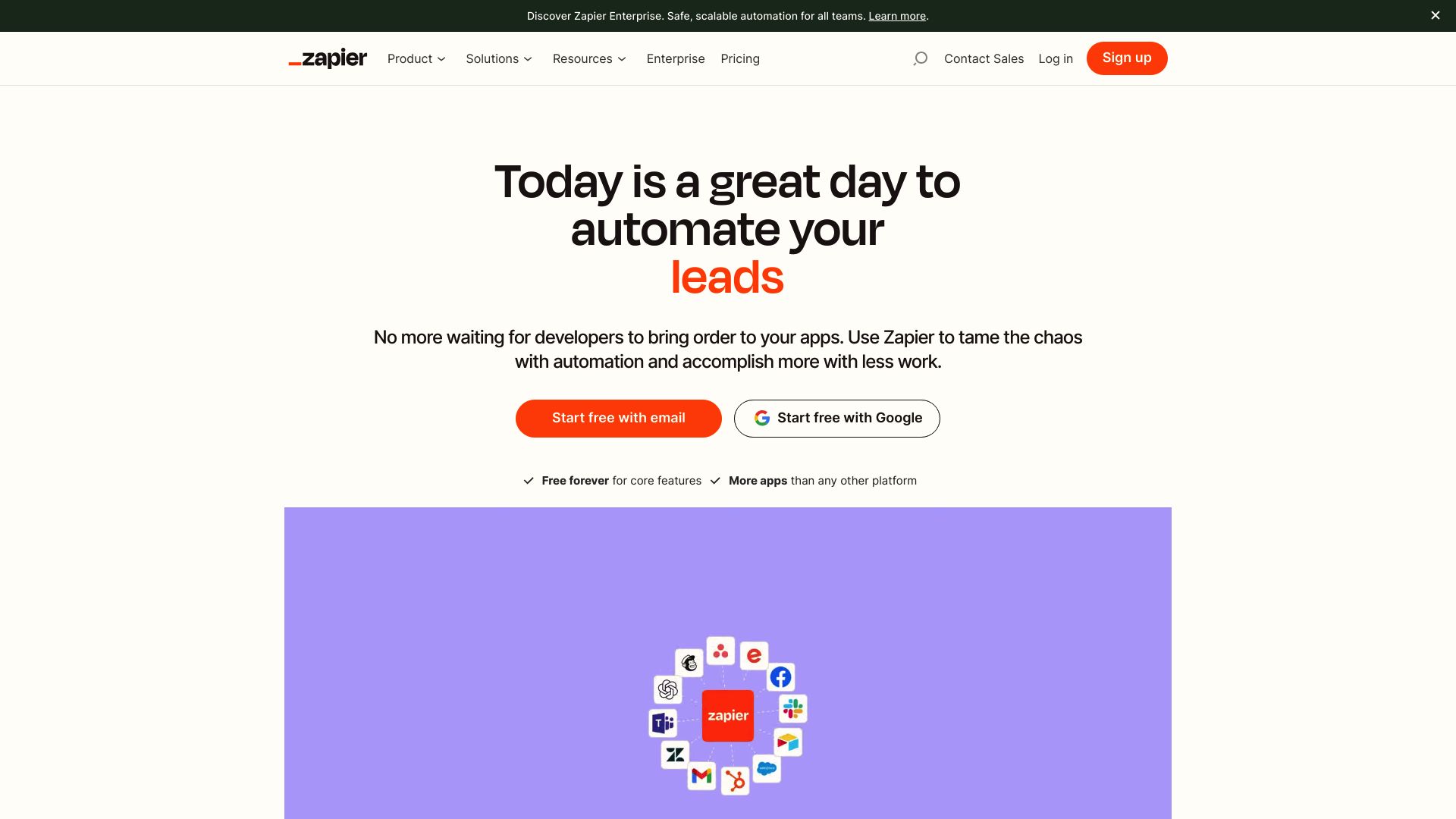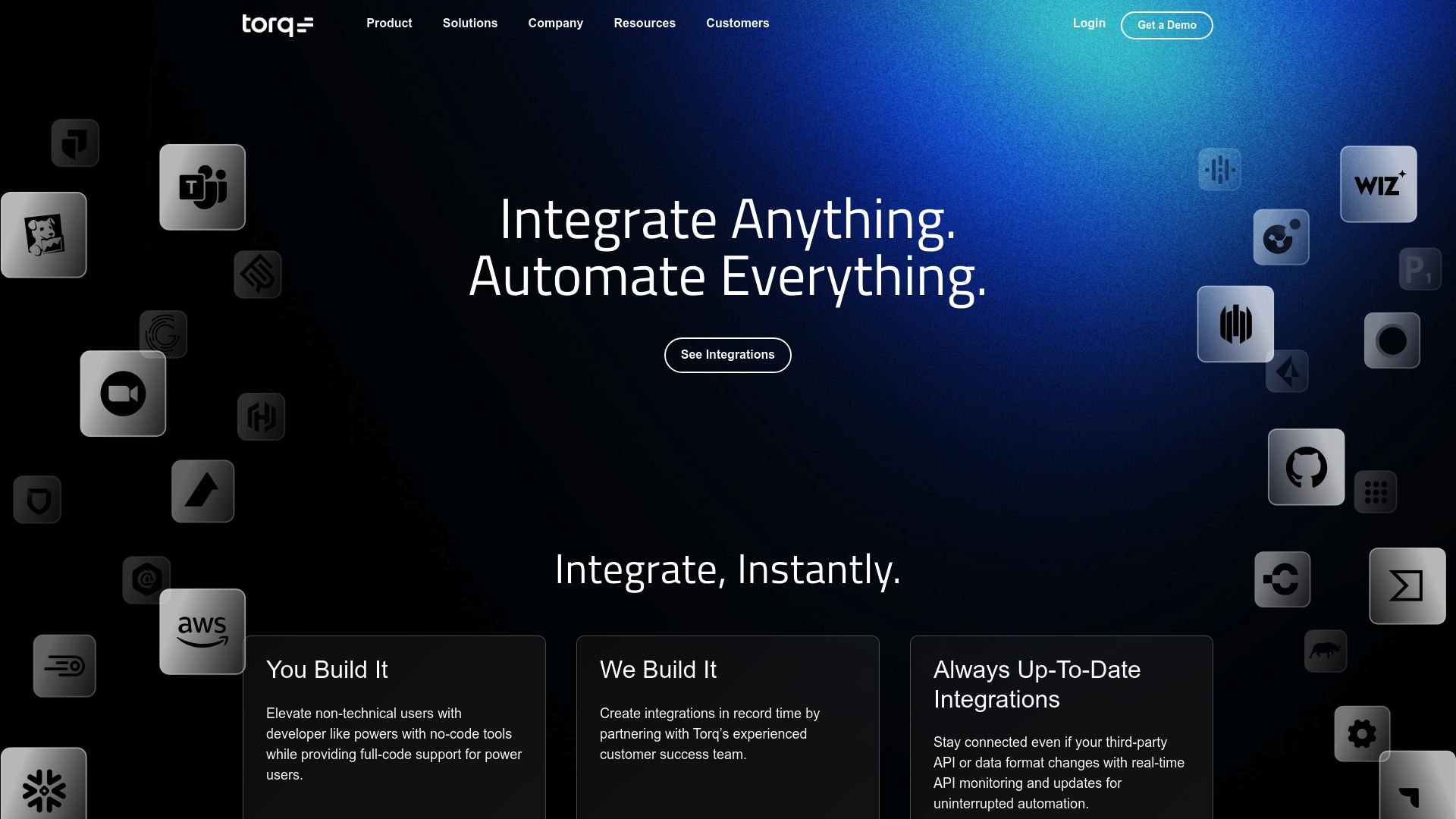Zapier vs. Torq Hyperautomation: AI-Driven Automation Showdown
Artificial intelligence has transformed the landscape of business automation, prompting organizations to seek powerful yet accessible solutions. Our comprehensive review compares three leading platforms: Zapier vs. Torq Hyperautomation, and SmythOS. We examine their unique approaches to workflow integration, security automation, and AI-driven processes.
This analysis covers key features, use cases, and overall effectiveness, helping you determine which platform best suits your organization’s needs. Whether you’re a developer seeking advanced AI capabilities, a business leader focused on scalability, or a non-technical user looking for intuitive tools, our comparison provides valuable insights to guide your decision-making process.
Zapier Overview
Zapier connects over 6,000 apps to automate workflows without coding. Its visual interface empowers users to create “Zaps” — multi-step workflows that link actions across different applications. Zapier caters to businesses seeking efficiency through automated task management and data synchronization.


Zapier’s strength lies in its extensive app integrations and user-friendly interface. The platform supports both basic and complex automations, from simple data transfers to multi-step processes involving multiple apps. This versatility makes it valuable for various industries, from marketing and sales to customer support and project management.
Zapier connects over 6,000 apps to automate workflows without coding. Its visual interface empowers users to create “Zaps” — multi-step workflows that link actions across different applications.
While Zapier excels in app integration, it lacks advanced AI capabilities. The platform doesn’t offer AI agents or autonomous problem-solving features, limiting its ability to handle complex, context-dependent tasks. For users needing simple, rules-based automations, Zapier provides a robust solution. However, those requiring more sophisticated AI-driven processes may find the platform’s capabilities insufficient.
Zapier’s development tools cater to different skill levels. The visual editor allows non-technical users to create workflows, while the Command Line Interface (CLI) gives developers more control for custom integrations. This dual approach broadens Zapier’s appeal, making it accessible to both citizen developers and professional programmers.
Zapier’s development tools cater to different skill levels. The visual editor allows non-technical users to create workflows, while the Command Line Interface (CLI) gives developers more control…
In the competitive landscape of automation tools, Zapier stands out for its vast app ecosystem and ease of use. However, as businesses increasingly seek AI-powered solutions, Zapier’s lack of advanced AI features may become a limitation. The platform’s focus on traditional automation workflows positions it as a reliable choice for straightforward integrations, but it may struggle to meet the growing demand for more intelligent, adaptive automation solutions.
Torq Hyperautomation Overview
Torq Hyperautomation delivers an AI-driven platform for enterprise-grade security operations, enabling organizations to automate complex security processes at scale. The platform connects the entire security infrastructure stack, allowing security teams to remediate events and orchestrate workflows instantly.


Torq’s platform offers customizable workflows, extensive third-party integrations, and automated case management. Key features include triggers that initiate workflows based on events, modular steps for specific actions, and persistent variables for data management during execution. The platform supports both no-code and advanced scripting options, catering to users with varying technical expertise.
Torq’s platform offers customizable workflows, extensive third-party integrations, and automated case management.
While Torq excels in security automation, it lacks some features found in more general AI agent builders. The platform doesn’t offer hosted AI agents, autonomous agents, or multimodal capabilities. However, it provides robust problem-solving capabilities through its customizable workflows and integrations.
Torq’s strengths lie in its security focus, extensive integration options, and scalability for enterprise needs. The platform offers audit logs, team collaboration features, and strong security measures including OAuth support. These features position Torq as a powerful tool for organizations looking to enhance their security operations through automation.
Despite its strengths, Torq may not be suitable for users seeking general-purpose AI agents or those requiring advanced AI functionalities like natural language processing or machine learning model deployment. The platform’s specialized nature makes it ideal for security-focused enterprises but potentially limiting for broader AI applications.
Feature Comparison
Zapier and Torq Hyperautomation differ significantly in their core capabilities and target use cases. Zapier excels as a general-purpose integration platform, connecting over 6,000 apps to automate workflows without coding. Its visual interface allows users to create multi-step workflows called “Zaps” that link actions across different applications. In contrast, Torq Hyperautomation specializes in AI-driven security operations, enabling organizations to automate complex security processes at scale.
While both platforms offer visual builders and no-code options, Torq Hyperautomation’s focus on security automation sets it apart. Torq provides customizable workflows specifically designed for security tasks, triggers based on security events, and automated case management for handling security incidents. Zapier, on the other hand, lacks these security-specific features but offers broader integration options across various business applications.
A key distinction lies in their AI capabilities. Torq Hyperautomation leverages AI for security operations, whereas Zapier does not incorporate advanced AI or machine learning features. This gap extends to areas like autonomous agents, multimodal capabilities, and AI-driven problem-solving, which are absent in both platforms but are strengths of SmythOS. Our platform offers hosted AI agents, autonomous problem-solving capabilities, and support for multimodal interactions, positioning SmythOS as a more comprehensive solution for AI-driven automation and agent development.
Feature Comparison Table
| Zapier | Torq Hyperautomation | SmythOS | |
|---|---|---|---|
| CORE FEATURES | |||
| AI Agents | ❌ | ✅ | ✅ |
| Hosted Agents (Dev, Production) | ❌ | ✅ | ✅ |
| Memory & Context | ❌ | ✅ | ✅ |
| Autonomous Agents | ❌ | ✅ | ✅ |
| Explainability & Transparency | ❌ | ❌ | ✅ |
| Multimodal | ❌ | ✅ | ✅ |
| Problem-Solving Capabilities | ❌ | ❌ | ✅ |
| Multi-Agent Collaboration | ❌ | ✅ | ✅ |
| Human-AI Interaction | ❌ | ❌ | ✅ |
| Agent Work Scheduler | ❌ | ✅ | ✅ |
| SECURITY | |||
| Constrained Alignment | ❌ | ✅ | ✅ |
| IP Control | ❌ | ✅ | ✅ |
| COMPONENTS | |||
| Foundation AIs | ❌ | ✅ | ✅ |
| Huggingface AIs | ❌ | ❌ | ✅ |
| Zapier APIs | ✅ | ❌ | ✅ |
| All other APIs, RPA | ✅ | ❌ | ✅ |
| Classifiers | ❌ | ✅ | ✅ |
| Logic | ❌ | ❌ | ✅ |
| Data Lakes | ❌ | ✅ | ✅ |
| DEPLOYMENT OPTIONS (EMBODIMENTS) | |||
| Deploy as API | ✅ | ❌ | ✅ |
| Production Domains | ✅ | ❌ | ✅ |
| API Authentication (OAuth + Key) | ✅ | ❌ | ✅ |
| Deploy as Site Chat | ❌ | ✅ | ✅ |
| Deploy as Scheduled Agent | ❌ | ❌ | ✅ |
| Deploy as GPT | ❌ | ✅ | ✅ |
| Scalability | ✅ | ❌ | ✅ |
| DATA LAKE SUPPORT | |||
| Hosted Vector Database | ❌ | ✅ | ✅ |
| Sitemap Crawler | ❌ | ❌ | ✅ |
| YouTube Transcript Crawler | ❌ | ❌ | ✅ |
| URL Crawler | ❌ | ❌ | ✅ |
| PDF Support | ❌ | ❌ | ✅ |
| Word File Support | ❌ | ✅ | ✅ |
| TXT File Support | ❌ | ✅ | ✅ |
Best Alternative to Zapier and Torq Hyperautomation
SmythOS stands out as a superior alternative to Zapier and Torq Hyperautomation, offering a comprehensive AI-driven automation platform that combines the best of both worlds while adding powerful new capabilities. Our platform empowers users to create and deploy sophisticated AI agents with unprecedented ease and flexibility.
Unlike Zapier’s focus on simple app integrations or Torq’s narrow emphasis on security automation, SmythOS provides a versatile ecosystem for building intelligent agents that can handle complex tasks across various domains. We offer a visual drag-and-drop interface that simplifies agent creation without sacrificing advanced functionality, making AI development accessible to both technical and non-technical users.
SmythOS provides a versatile ecosystem for building intelligent agents that can handle complex tasks across various domains.
SmythOS excels in its ability to support autonomous agents with memory and context awareness, features absent in both Zapier and Torq. This allows our agents to maintain conversation history, learn from interactions, and make more informed decisions over time. Additionally, our platform’s multi-agent collaboration capabilities enable the creation of sophisticated AI systems that can tackle intricate problems through teamwork, a feature neither competitor offers.
Where Zapier and Torq fall short in AI integration, SmythOS shines. We support a wide array of foundation models and Hugging Face AIs, allowing users to leverage cutting-edge machine learning technologies in their automation workflows. This, combined with our extensive API support and RPA capabilities, provides unparalleled flexibility in connecting various data sources and services.
With SmythOS, users gain access to advanced deployment options, including API endpoints, webhooks, site chat interfaces, and even integration with popular AI platforms like GPT. Our scalable infrastructure ensures that your AI solutions can grow with your business needs, offering enterprise-grade performance without compromising on ease of use. By choosing SmythOS, you’re not just selecting an automation tool—you’re embracing a future-proof platform that will drive innovation and efficiency across your organization.
Conclusion
Zapier, Torq Hyperautomation, and SmythOS each offer unique approaches to workflow automation and integration. Zapier excels in connecting diverse apps and services, making it ideal for businesses seeking straightforward, rule-based automations across multiple platforms. Torq Hyperautomation specializes in security operations, providing robust tools for enterprise-grade security automation. However, both platforms have limitations in advanced AI capabilities and flexibility.
SmythOS emerges as the superior choice, combining the strengths of integration and automation with cutting-edge AI capabilities. Our platform offers a comprehensive solution for businesses looking to harness the full potential of AI-driven automation. With features like hosted AI agents, autonomous problem-solving, and support for multimodal interactions, SmythOS provides unparalleled versatility and power.
Unlike Zapier and Torq, SmythOS enables users to create and deploy sophisticated AI agents across various platforms effortlessly. Our drag-and-drop interface and extensive integration ecosystem, boasting over 300,000 connections, allow for rapid development and deployment of AI solutions. This flexibility, combined with our robust security features and scalability, makes SmythOS an ideal choice for businesses of all sizes looking to innovate and streamline their operations.
To experience the future of AI-powered automation, we invite you to create a free SmythOS account. With our risk-free trial offering unlimited agents and a 30-day money-back guarantee, you can explore how SmythOS can transform your workflow and drive your business forward. Don’t just automate – innovate with SmythOS, where cutting-edge AI meets unparalleled ease of use.
Last updated:
Disclaimer: The information presented in this article is for general informational purposes only and is provided as is. While we strive to keep the content up-to-date and accurate, we make no representations or warranties of any kind, express or implied, about the completeness, accuracy, reliability, suitability, or availability of the information contained in this article.
Any reliance you place on such information is strictly at your own risk. We reserve the right to make additions, deletions, or modifications to the contents of this article at any time without prior notice.
In no event will we be liable for any loss or damage including without limitation, indirect or consequential loss or damage, or any loss or damage whatsoever arising from loss of data, profits, or any other loss not specified herein arising out of, or in connection with, the use of this article.
Despite our best efforts, this article may contain oversights, errors, or omissions. If you notice any inaccuracies or have concerns about the content, please report them through our content feedback form. Your input helps us maintain the quality and reliability of our information.
